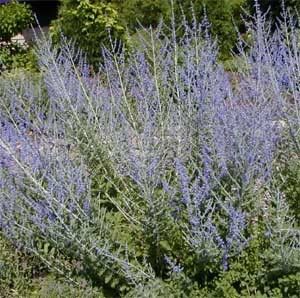My Favorite Deer Resistant Perennial
Russian Sage produce clumps of attractive gray-white stems that arch outward at the base, then becomes upright toward the tips, creating a nery neat "shrub" for the garden. Where the fuzzy gray-green leaves stop, the flowers begin! These tiny, two-lipped, tubular blooms appear in shuch profusion that the whole top of the plant is a haze of lavender-blue. Although Russian Sages develop woody bases and are very shrublike in appearance, they die back nearly to the ground in the winter, as do most other perennials.
Russian sages do have their preferences but will grow under most conditions if you give them two things: good drainage and full sun. If your climate is naturally dry, you can plant them anywhere. Elsewhere, though, it's worth looking for a well-drained spot, perhaps in a raised bed, just to make sure Russian sages nerer sit in water. It's no use trying to grow these plants in shad or even partial shade, they simply won't perform.
The subshrubby nature of Russian sages means they need rather different treatment from other perennials. Don't cut the plants back to the base in the spring because they normoally sprout from above ground level. Instead, if you insist on early prunning, but the plants back to about 1 foot from the ground. Otherwise, just wait until they start to sprout on their own, then cut them back to just above the lowest buds.
In mild-winter areas, Russian Sages are up and blooming so early that they can peter out by late summer. If so, simply chop them back to just above the upper learve and they will soon be blooming again. Elsewhere, summer pruning isn't necessary; Russian sages will bloom nonstop until the first hard frost all on their own.
The Plant name is PEROVSKIA, color is light blue, blooms summer to fall, blooms 3 months or more, up to 3-5 ft tall with a 2-4 ft spread. The best part is that the DEER don't like it.
